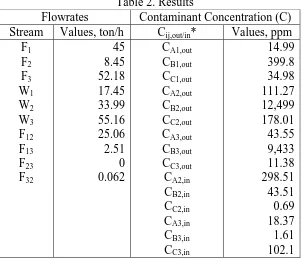Table 2. Results
Flowrates Contaminant Concentration (C) Stream Values, ton/h Cij,out/in* Values, ppm
F1 F2 F3 W1 W2 W3 F12 F13 F23 F32 45 8.45 52.18 17.45 33.99 55.16 25.06 2.51 0 0.062 CA1,out CB1,out CC1,out CA2,out CB2,out CC2,out CA3,out CB3,out CC3,out CA2,in CB2,in CC2,in CA3,in CB3,in CC3,in 14.99 399.8 34.98 111.27 12,499 178.01 43.55 9,433 11.38 298.51 43.51 0.69 18.37 1.61 102.1 *i = species (A,B, or C), j = equipment number.
VI. Conclusion
Mathematical approach based on mass balance has been used in minimization of fresh water consumption for multi contaminant mass exchanger network. The non-linear programming is used for the water allocation problem being studied. The results can be obtained effectively by using Matlab Optimization Toolbox.
VII. Reference
1. Bagajewicz, M. (2000). A Review of Recent Design Procedures for Water Networks in Refineries and Process Plants. Computer and Chemical Engineering, 24, pp.2093-2113. 2. Doyle, S.J, & Smith, R. (1997). Targeting Water Reuse with Multiple Contaminants.
Trans. IChemE, 75, Part B, pp. 181-189.
3. El-Halwagi, M.M.. (1997). Pollution Prevention through Process Integration: Systematic Design Tools. California, USA: Academic Press.
4. Li , B.H., and Chang, C.T. (2007). A Simple and Efficient Intitialization Strategy for Optimizing Water-Using Network Design. Ind. Eng. Chem. Res., 46, 8781 – 8786.
5. Perry, R.H., and Green, D.W. (1997). Perry’s Chemical Engineers’ Handbook. 7th Ed. 6. Saeedi, M and Hosseinzadeh, M. (2006). Optimization of Water Consumption in
Industrial System using Linear and Nonlinear Programming. Journal of Applied Sciences, 6 (11), pp. 2386 – 2393).
7. Savelski, M. and Bagajewicz, M. (2003). On the Necessary Conditions of Optimality of Water Utilization Systems in Process Plants with Multiple Contaminants. Chem. Eng. Sci, 58, pp. 5349 – 5362.
9. Wang, Y.P., and Smith. R (1994). Wastewater Minimization. Chem. Eng. Sci, 49 (7), pp.981-1006.
